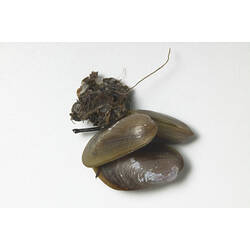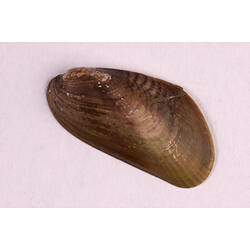General Description
Shell thin and quite fragile, small and elongate and radial ridges. Unlike most mussels, the umbo (the point from which the shell grows, situated above the hinge point between the two shells) is not at the most pointed end of the shell, but slightly forward along the edge. Exterior of shell a shiny olive green to brown in colour, often with darker purple-brown mottling or wavy or zig-zag lines. Interior of shell glossy grey-purple. Shell up to 3 cm across.
Biology
This species is native to the north western Pacific, with a natural distribution including Siberia, Korea, China and Japan. Populations are now established in many localities around the world, western USA (1940's), New Zealand (1970's), Mediterranean (1980's), Swan Estuary, WA (1980's) and Victoria (late 1980's). Introductions have been attributed to ballast water and ship fouling. They are considered a pest species in most parts of the World. Tolerant of low oxygen concentrations and low salinities helps them to survive in these locations. Like other mussels, they attach to their substrate using strong threads (byssal threads). Unlike other mussels, they also use these threads to form a bag around themselves, trapping sediment particles. They occur in dense patches, often with several thousand individuals per square metre. Predators include diving ducks, oyster catchers and several species of gastropods. This mussel is harvested for food in Asia but not in Australia.
Distribution
Worldwide. In Australia, mainly Western Australian, Tasmanian and Victorian waters.
Habitat
In or on hard or soft substrates, from intertidal areas to depth of 20 m.
More Information
-
Animal Type
-
Animal SubType
-
Brief Id
Shell thin, elongate, dark green to brown, usually with stripy patternation , glossy interior
-
Colours
Green, Brown
-
Habitats
-
Diet
Plankton or Particles
-
Endemicity
-
Commercial
No
-
Conservation Statuses
CITES: Not listed, FFG Threatened List: Not listed, DSE Advisory List: Not listed, IUCN Red List: Not listed
-
Depths
Shore (0-1 m), Shallow (1-30 m)
-
Water Column Locations
On or near seafloor
-
Taxon Name
-
Scientific Author
(Benson, 1842)
-
Common Name
Senhouse's Mussel
-
Other Names
Hototogisu
-
Phylum
-
Subphylum
-
Class
-
Subclass
-
Order
-
Family
-
Genus
-
Species Name
senhousia






